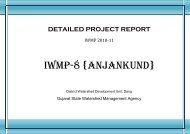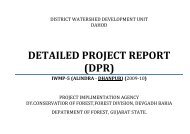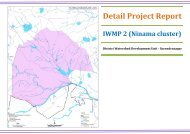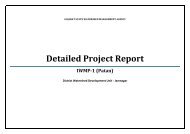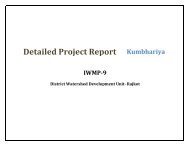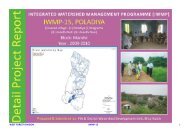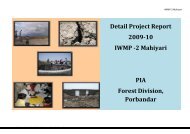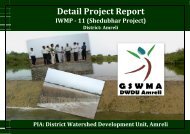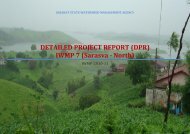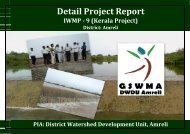IWMP-1 - Commissionerate of Rural Development Gujarat State
IWMP-1 - Commissionerate of Rural Development Gujarat State
IWMP-1 - Commissionerate of Rural Development Gujarat State
Create successful ePaper yourself
Turn your PDF publications into a flip-book with our unique Google optimized e-Paper software.
Bio-physical survey was undertaken to identify various natural resources available in the village. It included the soil typology, well in the<br />
area, crop taken in the field, Cropping pattern, fertilizer used and various sources <strong>of</strong> irrigation in the field.<br />
iii)<br />
Participatory <strong>Rural</strong> Appraisal (PRA)<br />
The past experience <strong>of</strong> watershed has given tremendous input to focus on creating accountability <strong>of</strong> the stakeholders towards the<br />
programme. This has created an emphasis to include all the stakeholder communities and their local and indigenous Technological Knowledge<br />
(ITK) while planning for any activity. Participatory approach provides a new path for planning, implementing, and monitoring and postwithdrawal<br />
activities with a complete accountability <strong>of</strong> the stakeholders. Various PRA techniques like resource mapping, social mapping and<br />
season calendars were used to understand the physical and social orientation <strong>of</strong> the village in general and watershed in specific. These tools put<br />
the villagers in ease than the complicated questionnaires. Various tools like Matrix ranking, Venn diagram were used to identify various local<br />
vegetations (apt for afforestation), Fodders crops, various institutions and their significance in the life <strong>of</strong> the farmers. Daily routine activity<br />
helps the daily chart or life span <strong>of</strong> the villagers.<br />
iv)<br />
Use <strong>of</strong> GIS and Remote sensing for planning<br />
Use <strong>of</strong> various high science tools has been promoted at various stages <strong>of</strong> watershed development.<br />
a) Prioritization<br />
Geographical Information System (GIS) has been used for prioritization process. Various layer maps were created like Geomorphological,<br />
Soil, BPL Population, SC/ST population, Ground water Status, Drinking water situation Slope percent. These were all given<br />
proper weightage according to the DoLR specification. This helped in prioritization <strong>of</strong> various watershed areas.<br />
West Forest Division- Rajpipla Page 45



